Customer Experience Report: Analyzing TESCO's Strategies, MG526
VerifiedAdded on 2023/06/05
|10
|3265
|290
Report
AI Summary
This report provides a comprehensive analysis of TESCO's customer experience strategies. It begins with an introduction to customer experience and its impact on business success, followed by an examination of TESCO's value proposition, including its loyalty programs and private labels. The report then delves into how TESCO manifests and delivers customer experiences, identifies its main consumer targets, and explores the six key elements of an experience model. It further discusses the consumer implication model and the applications of digital disruption within TESCO, offering recommendations based on the analysis. The report highlights the importance of customer feedback, data analysis, and understanding target markets for enhancing customer satisfaction and loyalty. Overall, the report provides a detailed overview of TESCO's customer-centric approach and its implications for the company's success.
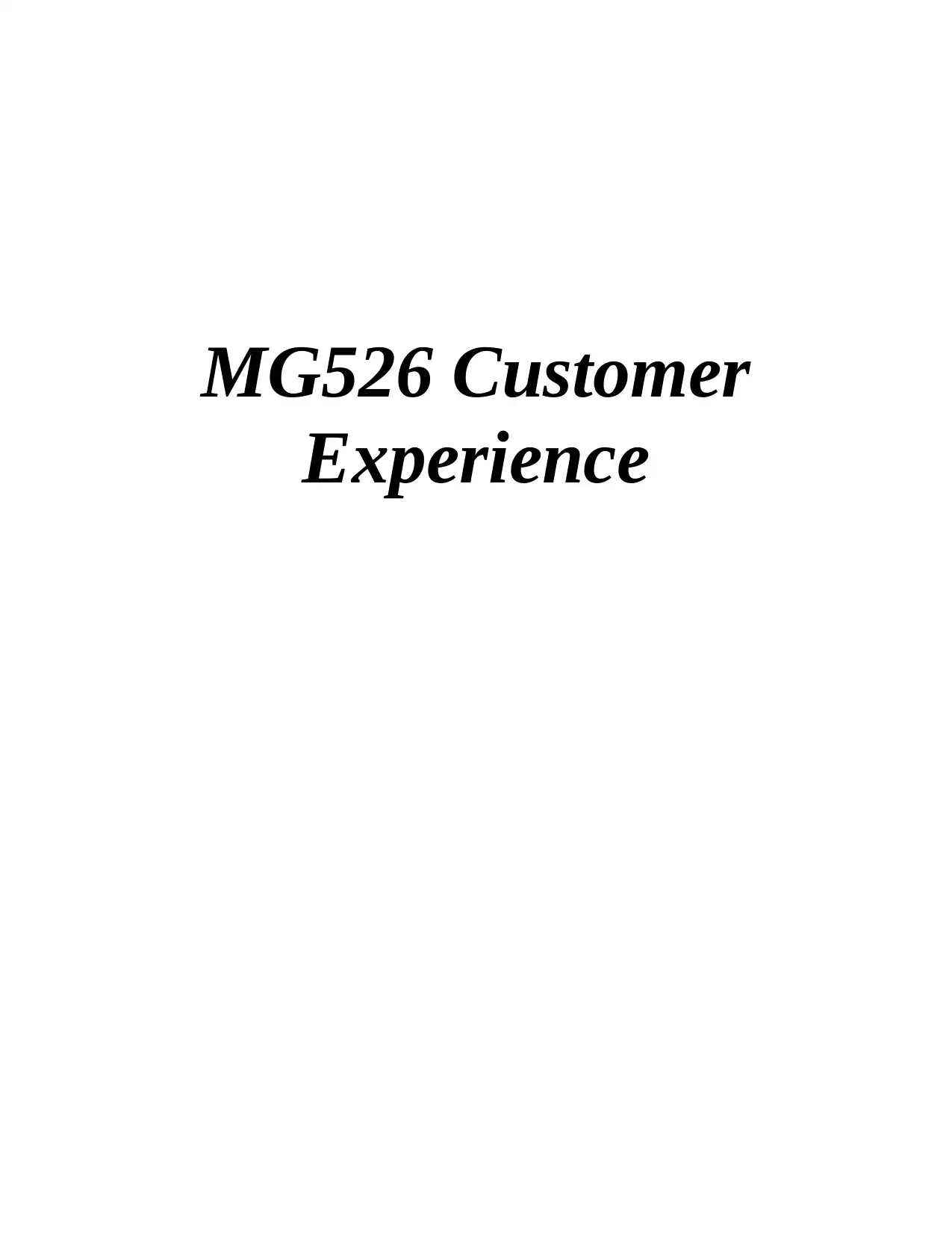
MG526 Customer
Experience
Experience
Paraphrase This Document
Need a fresh take? Get an instant paraphrase of this document with our AI Paraphraser
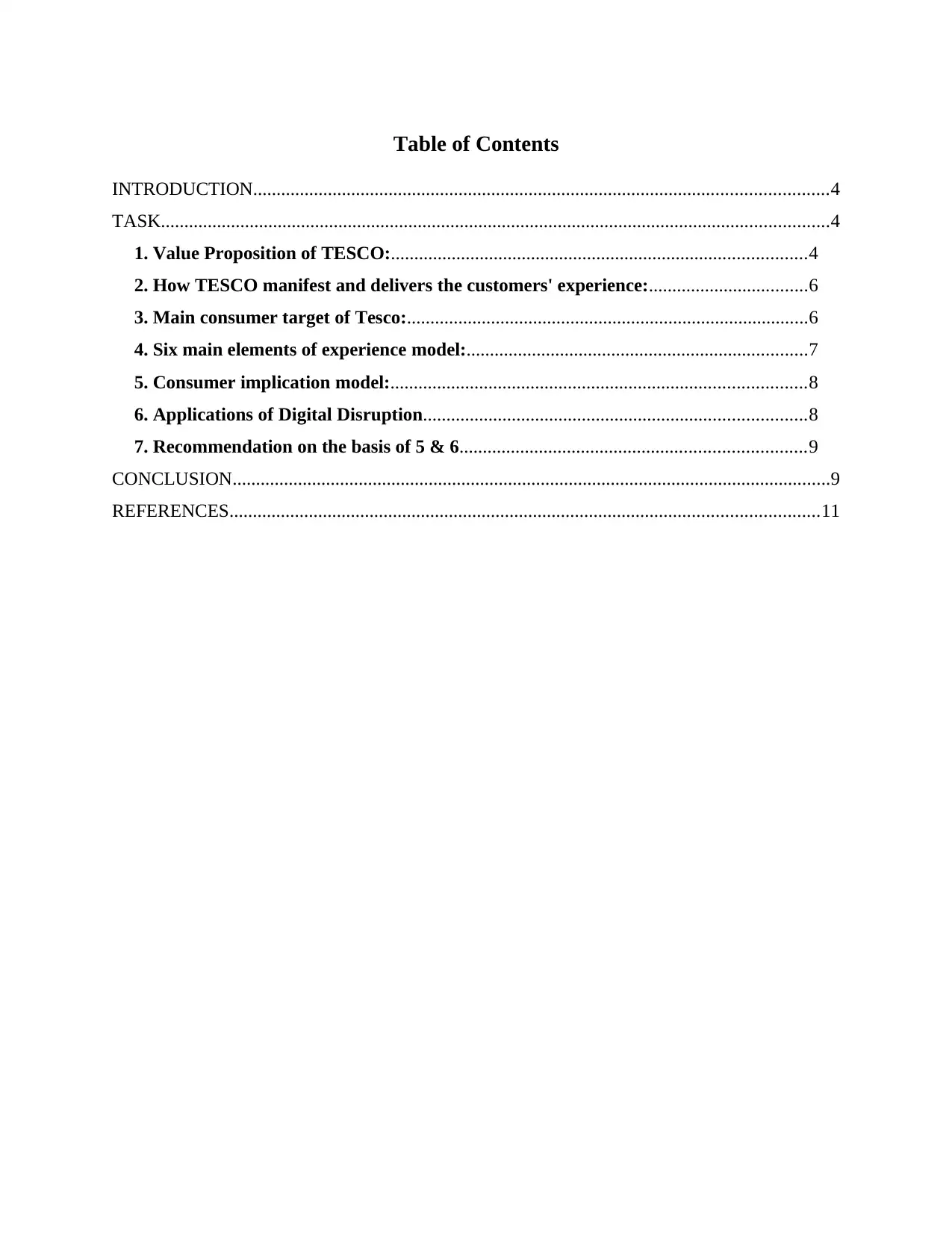
Table of Contents
INTRODUCTION...........................................................................................................................4
TASK...............................................................................................................................................4
1. Value Proposition of TESCO:.........................................................................................4
2. How TESCO manifest and delivers the customers' experience:..................................6
3. Main consumer target of Tesco:......................................................................................6
4. Six main elements of experience model:.........................................................................7
5. Consumer implication model:.........................................................................................8
6. Applications of Digital Disruption..................................................................................8
7. Recommendation on the basis of 5 & 6..........................................................................9
CONCLUSION................................................................................................................................9
REFERENCES..............................................................................................................................11
INTRODUCTION...........................................................................................................................4
TASK...............................................................................................................................................4
1. Value Proposition of TESCO:.........................................................................................4
2. How TESCO manifest and delivers the customers' experience:..................................6
3. Main consumer target of Tesco:......................................................................................6
4. Six main elements of experience model:.........................................................................7
5. Consumer implication model:.........................................................................................8
6. Applications of Digital Disruption..................................................................................8
7. Recommendation on the basis of 5 & 6..........................................................................9
CONCLUSION................................................................................................................................9
REFERENCES..............................................................................................................................11
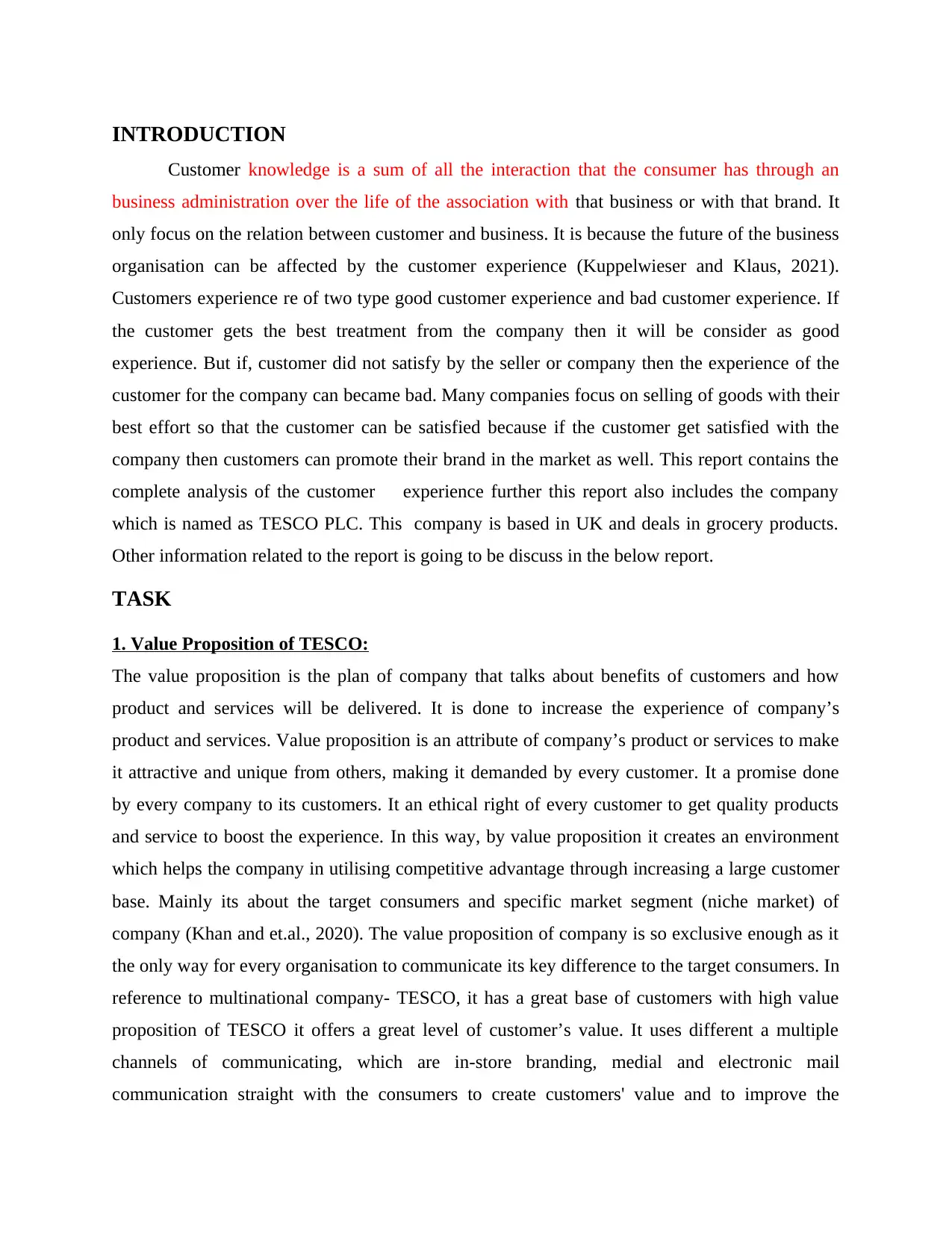
INTRODUCTION
Customer knowledge is a sum of all the interaction that the consumer has through an
business administration over the life of the association with that business or with that brand. It
only focus on the relation between customer and business. It is because the future of the business
organisation can be affected by the customer experience (Kuppelwieser and Klaus, 2021).
Customers experience re of two type good customer experience and bad customer experience. If
the customer gets the best treatment from the company then it will be consider as good
experience. But if, customer did not satisfy by the seller or company then the experience of the
customer for the company can became bad. Many companies focus on selling of goods with their
best effort so that the customer can be satisfied because if the customer get satisfied with the
company then customers can promote their brand in the market as well. This report contains the
complete analysis of the customer experience further this report also includes the company
which is named as TESCO PLC. This company is based in UK and deals in grocery products.
Other information related to the report is going to be discuss in the below report.
TASK
1. Value Proposition of TESCO:
The value proposition is the plan of company that talks about benefits of customers and how
product and services will be delivered. It is done to increase the experience of company’s
product and services. Value proposition is an attribute of company’s product or services to make
it attractive and unique from others, making it demanded by every customer. It a promise done
by every company to its customers. It an ethical right of every customer to get quality products
and service to boost the experience. In this way, by value proposition it creates an environment
which helps the company in utilising competitive advantage through increasing a large customer
base. Mainly its about the target consumers and specific market segment (niche market) of
company (Khan and et.al., 2020). The value proposition of company is so exclusive enough as it
the only way for every organisation to communicate its key difference to the target consumers. In
reference to multinational company- TESCO, it has a great base of customers with high value
proposition of TESCO it offers a great level of customer’s value. It uses different a multiple
channels of communicating, which are in-store branding, medial and electronic mail
communication straight with the consumers to create customers' value and to improve the
Customer knowledge is a sum of all the interaction that the consumer has through an
business administration over the life of the association with that business or with that brand. It
only focus on the relation between customer and business. It is because the future of the business
organisation can be affected by the customer experience (Kuppelwieser and Klaus, 2021).
Customers experience re of two type good customer experience and bad customer experience. If
the customer gets the best treatment from the company then it will be consider as good
experience. But if, customer did not satisfy by the seller or company then the experience of the
customer for the company can became bad. Many companies focus on selling of goods with their
best effort so that the customer can be satisfied because if the customer get satisfied with the
company then customers can promote their brand in the market as well. This report contains the
complete analysis of the customer experience further this report also includes the company
which is named as TESCO PLC. This company is based in UK and deals in grocery products.
Other information related to the report is going to be discuss in the below report.
TASK
1. Value Proposition of TESCO:
The value proposition is the plan of company that talks about benefits of customers and how
product and services will be delivered. It is done to increase the experience of company’s
product and services. Value proposition is an attribute of company’s product or services to make
it attractive and unique from others, making it demanded by every customer. It a promise done
by every company to its customers. It an ethical right of every customer to get quality products
and service to boost the experience. In this way, by value proposition it creates an environment
which helps the company in utilising competitive advantage through increasing a large customer
base. Mainly its about the target consumers and specific market segment (niche market) of
company (Khan and et.al., 2020). The value proposition of company is so exclusive enough as it
the only way for every organisation to communicate its key difference to the target consumers. In
reference to multinational company- TESCO, it has a great base of customers with high value
proposition of TESCO it offers a great level of customer’s value. It uses different a multiple
channels of communicating, which are in-store branding, medial and electronic mail
communication straight with the consumers to create customers' value and to improve the
⊘ This is a preview!⊘
Do you want full access?
Subscribe today to unlock all pages.

Trusted by 1+ million students worldwide
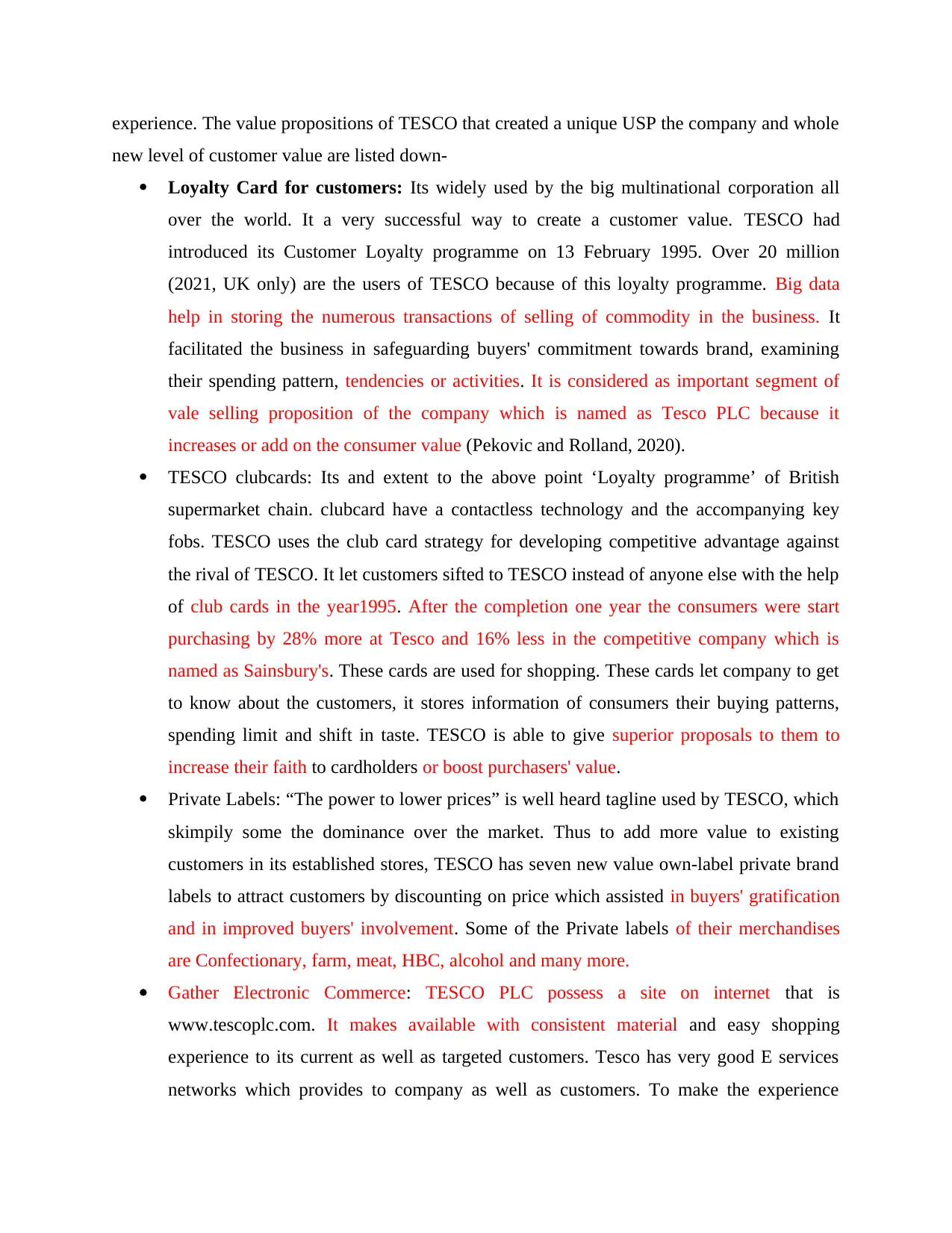
experience. The value propositions of TESCO that created a unique USP the company and whole
new level of customer value are listed down-
Loyalty Card for customers: Its widely used by the big multinational corporation all
over the world. It a very successful way to create a customer value. TESCO had
introduced its Customer Loyalty programme on 13 February 1995. Over 20 million
(2021, UK only) are the users of TESCO because of this loyalty programme. Big data
help in storing the numerous transactions of selling of commodity in the business. It
facilitated the business in safeguarding buyers' commitment towards brand, examining
their spending pattern, tendencies or activities. It is considered as important segment of
vale selling proposition of the company which is named as Tesco PLC because it
increases or add on the consumer value (Pekovic and Rolland, 2020).
TESCO clubcards: Its and extent to the above point ‘Loyalty programme’ of British
supermarket chain. clubcard have a contactless technology and the accompanying key
fobs. TESCO uses the club card strategy for developing competitive advantage against
the rival of TESCO. It let customers sifted to TESCO instead of anyone else with the help
of club cards in the year1995. After the completion one year the consumers were start
purchasing by 28% more at Tesco and 16% less in the competitive company which is
named as Sainsbury's. These cards are used for shopping. These cards let company to get
to know about the customers, it stores information of consumers their buying patterns,
spending limit and shift in taste. TESCO is able to give superior proposals to them to
increase their faith to cardholders or boost purchasers' value.
Private Labels: “The power to lower prices” is well heard tagline used by TESCO, which
skimpily some the dominance over the market. Thus to add more value to existing
customers in its established stores, TESCO has seven new value own-label private brand
labels to attract customers by discounting on price which assisted in buyers' gratification
and in improved buyers' involvement. Some of the Private labels of their merchandises
are Confectionary, farm, meat, HBC, alcohol and many more.
Gather Electronic Commerce: TESCO PLC possess a site on internet that is
www.tescoplc.com. It makes available with consistent material and easy shopping
experience to its current as well as targeted customers. Tesco has very good E services
networks which provides to company as well as customers. To make the experience
new level of customer value are listed down-
Loyalty Card for customers: Its widely used by the big multinational corporation all
over the world. It a very successful way to create a customer value. TESCO had
introduced its Customer Loyalty programme on 13 February 1995. Over 20 million
(2021, UK only) are the users of TESCO because of this loyalty programme. Big data
help in storing the numerous transactions of selling of commodity in the business. It
facilitated the business in safeguarding buyers' commitment towards brand, examining
their spending pattern, tendencies or activities. It is considered as important segment of
vale selling proposition of the company which is named as Tesco PLC because it
increases or add on the consumer value (Pekovic and Rolland, 2020).
TESCO clubcards: Its and extent to the above point ‘Loyalty programme’ of British
supermarket chain. clubcard have a contactless technology and the accompanying key
fobs. TESCO uses the club card strategy for developing competitive advantage against
the rival of TESCO. It let customers sifted to TESCO instead of anyone else with the help
of club cards in the year1995. After the completion one year the consumers were start
purchasing by 28% more at Tesco and 16% less in the competitive company which is
named as Sainsbury's. These cards are used for shopping. These cards let company to get
to know about the customers, it stores information of consumers their buying patterns,
spending limit and shift in taste. TESCO is able to give superior proposals to them to
increase their faith to cardholders or boost purchasers' value.
Private Labels: “The power to lower prices” is well heard tagline used by TESCO, which
skimpily some the dominance over the market. Thus to add more value to existing
customers in its established stores, TESCO has seven new value own-label private brand
labels to attract customers by discounting on price which assisted in buyers' gratification
and in improved buyers' involvement. Some of the Private labels of their merchandises
are Confectionary, farm, meat, HBC, alcohol and many more.
Gather Electronic Commerce: TESCO PLC possess a site on internet that is
www.tescoplc.com. It makes available with consistent material and easy shopping
experience to its current as well as targeted customers. Tesco has very good E services
networks which provides to company as well as customers. To make the experience
Paraphrase This Document
Need a fresh take? Get an instant paraphrase of this document with our AI Paraphraser
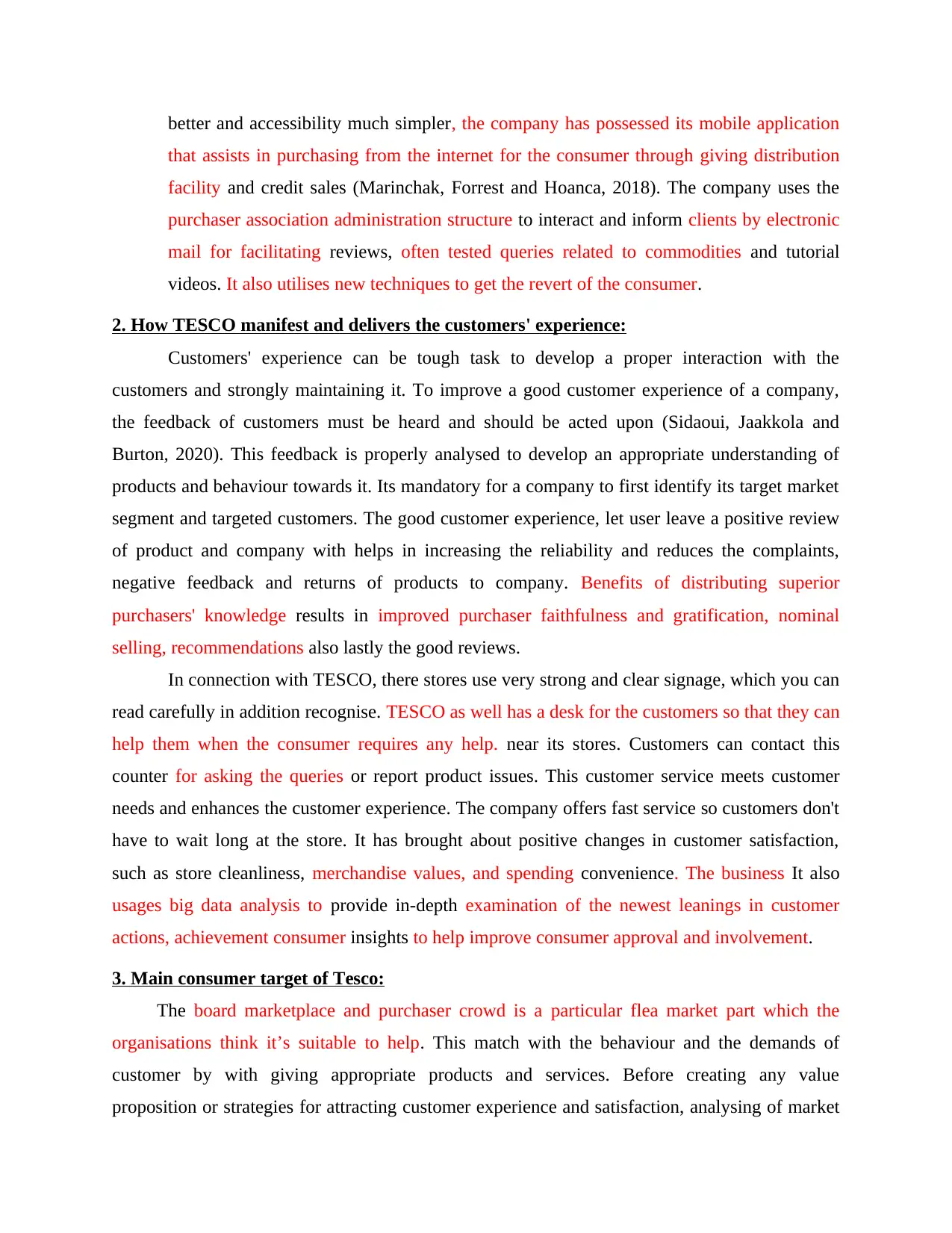
better and accessibility much simpler, the company has possessed its mobile application
that assists in purchasing from the internet for the consumer through giving distribution
facility and credit sales (Marinchak, Forrest and Hoanca, 2018). The company uses the
purchaser association administration structure to interact and inform clients by electronic
mail for facilitating reviews, often tested queries related to commodities and tutorial
videos. It also utilises new techniques to get the revert of the consumer.
2. How TESCO manifest and delivers the customers' experience:
Customers' experience can be tough task to develop a proper interaction with the
customers and strongly maintaining it. To improve a good customer experience of a company,
the feedback of customers must be heard and should be acted upon (Sidaoui, Jaakkola and
Burton, 2020). This feedback is properly analysed to develop an appropriate understanding of
products and behaviour towards it. Its mandatory for a company to first identify its target market
segment and targeted customers. The good customer experience, let user leave a positive review
of product and company with helps in increasing the reliability and reduces the complaints,
negative feedback and returns of products to company. Benefits of distributing superior
purchasers' knowledge results in improved purchaser faithfulness and gratification, nominal
selling, recommendations also lastly the good reviews.
In connection with TESCO, there stores use very strong and clear signage, which you can
read carefully in addition recognise. TESCO as well has a desk for the customers so that they can
help them when the consumer requires any help. near its stores. Customers can contact this
counter for asking the queries or report product issues. This customer service meets customer
needs and enhances the customer experience. The company offers fast service so customers don't
have to wait long at the store. It has brought about positive changes in customer satisfaction,
such as store cleanliness, merchandise values, and spending convenience. The business It also
usages big data analysis to provide in-depth examination of the newest leanings in customer
actions, achievement consumer insights to help improve consumer approval and involvement.
3. Main consumer target of Tesco:
The board marketplace and purchaser crowd is a particular flea market part which the
organisations think it’s suitable to help. This match with the behaviour and the demands of
customer by with giving appropriate products and services. Before creating any value
proposition or strategies for attracting customer experience and satisfaction, analysing of market
that assists in purchasing from the internet for the consumer through giving distribution
facility and credit sales (Marinchak, Forrest and Hoanca, 2018). The company uses the
purchaser association administration structure to interact and inform clients by electronic
mail for facilitating reviews, often tested queries related to commodities and tutorial
videos. It also utilises new techniques to get the revert of the consumer.
2. How TESCO manifest and delivers the customers' experience:
Customers' experience can be tough task to develop a proper interaction with the
customers and strongly maintaining it. To improve a good customer experience of a company,
the feedback of customers must be heard and should be acted upon (Sidaoui, Jaakkola and
Burton, 2020). This feedback is properly analysed to develop an appropriate understanding of
products and behaviour towards it. Its mandatory for a company to first identify its target market
segment and targeted customers. The good customer experience, let user leave a positive review
of product and company with helps in increasing the reliability and reduces the complaints,
negative feedback and returns of products to company. Benefits of distributing superior
purchasers' knowledge results in improved purchaser faithfulness and gratification, nominal
selling, recommendations also lastly the good reviews.
In connection with TESCO, there stores use very strong and clear signage, which you can
read carefully in addition recognise. TESCO as well has a desk for the customers so that they can
help them when the consumer requires any help. near its stores. Customers can contact this
counter for asking the queries or report product issues. This customer service meets customer
needs and enhances the customer experience. The company offers fast service so customers don't
have to wait long at the store. It has brought about positive changes in customer satisfaction,
such as store cleanliness, merchandise values, and spending convenience. The business It also
usages big data analysis to provide in-depth examination of the newest leanings in customer
actions, achievement consumer insights to help improve consumer approval and involvement.
3. Main consumer target of Tesco:
The board marketplace and purchaser crowd is a particular flea market part which the
organisations think it’s suitable to help. This match with the behaviour and the demands of
customer by with giving appropriate products and services. Before creating any value
proposition or strategies for attracting customer experience and satisfaction, analysing of market
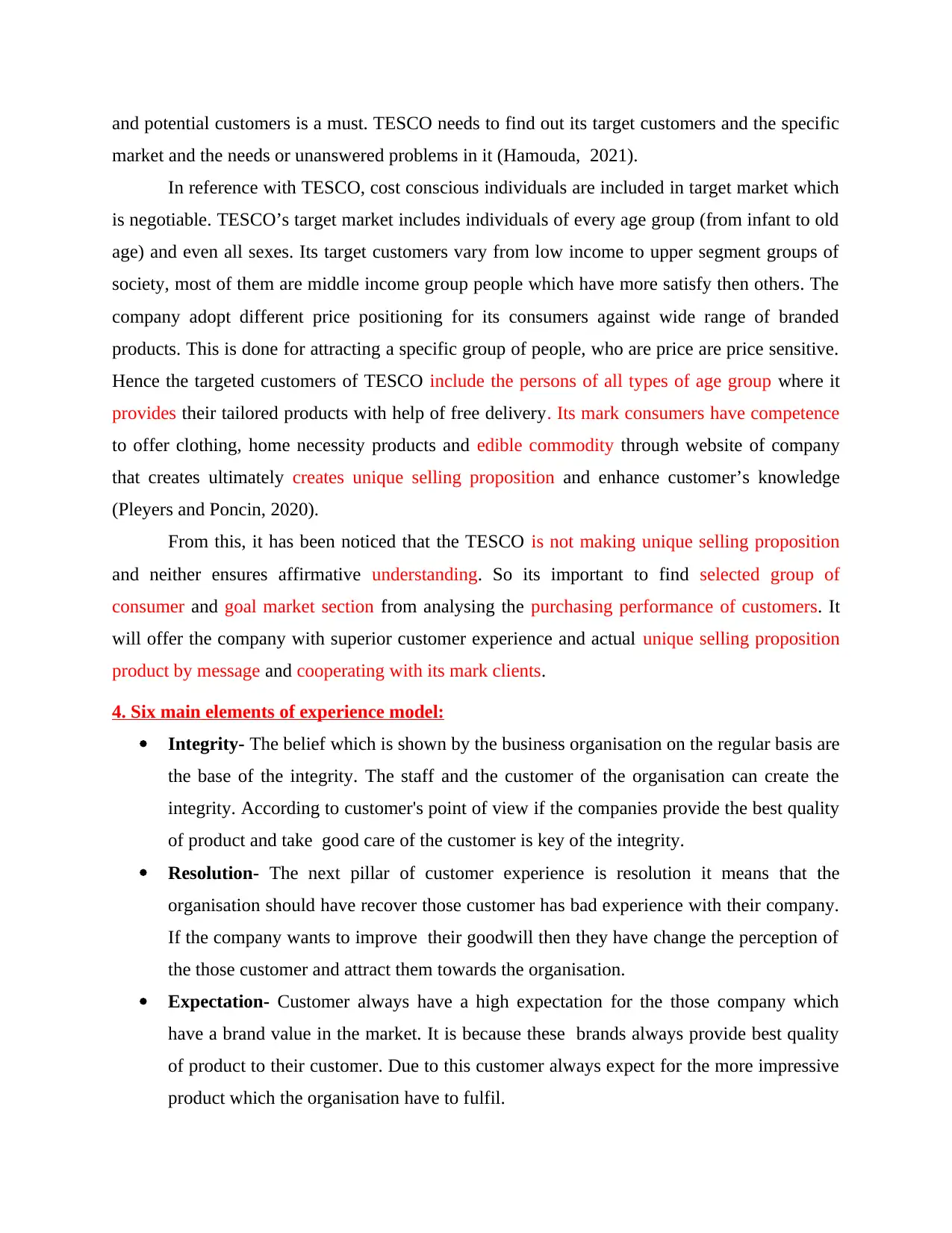
and potential customers is a must. TESCO needs to find out its target customers and the specific
market and the needs or unanswered problems in it (Hamouda, 2021).
In reference with TESCO, cost conscious individuals are included in target market which
is negotiable. TESCO’s target market includes individuals of every age group (from infant to old
age) and even all sexes. Its target customers vary from low income to upper segment groups of
society, most of them are middle income group people which have more satisfy then others. The
company adopt different price positioning for its consumers against wide range of branded
products. This is done for attracting a specific group of people, who are price are price sensitive.
Hence the targeted customers of TESCO include the persons of all types of age group where it
provides their tailored products with help of free delivery. Its mark consumers have competence
to offer clothing, home necessity products and edible commodity through website of company
that creates ultimately creates unique selling proposition and enhance customer’s knowledge
(Pleyers and Poncin, 2020).
From this, it has been noticed that the TESCO is not making unique selling proposition
and neither ensures affirmative understanding. So its important to find selected group of
consumer and goal market section from analysing the purchasing performance of customers. It
will offer the company with superior customer experience and actual unique selling proposition
product by message and cooperating with its mark clients.
4. Six main elements of experience model:
Integrity- The belief which is shown by the business organisation on the regular basis are
the base of the integrity. The staff and the customer of the organisation can create the
integrity. According to customer's point of view if the companies provide the best quality
of product and take good care of the customer is key of the integrity.
Resolution- The next pillar of customer experience is resolution it means that the
organisation should have recover those customer has bad experience with their company.
If the company wants to improve their goodwill then they have change the perception of
the those customer and attract them towards the organisation.
Expectation- Customer always have a high expectation for the those company which
have a brand value in the market. It is because these brands always provide best quality
of product to their customer. Due to this customer always expect for the more impressive
product which the organisation have to fulfil.
market and the needs or unanswered problems in it (Hamouda, 2021).
In reference with TESCO, cost conscious individuals are included in target market which
is negotiable. TESCO’s target market includes individuals of every age group (from infant to old
age) and even all sexes. Its target customers vary from low income to upper segment groups of
society, most of them are middle income group people which have more satisfy then others. The
company adopt different price positioning for its consumers against wide range of branded
products. This is done for attracting a specific group of people, who are price are price sensitive.
Hence the targeted customers of TESCO include the persons of all types of age group where it
provides their tailored products with help of free delivery. Its mark consumers have competence
to offer clothing, home necessity products and edible commodity through website of company
that creates ultimately creates unique selling proposition and enhance customer’s knowledge
(Pleyers and Poncin, 2020).
From this, it has been noticed that the TESCO is not making unique selling proposition
and neither ensures affirmative understanding. So its important to find selected group of
consumer and goal market section from analysing the purchasing performance of customers. It
will offer the company with superior customer experience and actual unique selling proposition
product by message and cooperating with its mark clients.
4. Six main elements of experience model:
Integrity- The belief which is shown by the business organisation on the regular basis are
the base of the integrity. The staff and the customer of the organisation can create the
integrity. According to customer's point of view if the companies provide the best quality
of product and take good care of the customer is key of the integrity.
Resolution- The next pillar of customer experience is resolution it means that the
organisation should have recover those customer has bad experience with their company.
If the company wants to improve their goodwill then they have change the perception of
the those customer and attract them towards the organisation.
Expectation- Customer always have a high expectation for the those company which
have a brand value in the market. It is because these brands always provide best quality
of product to their customer. Due to this customer always expect for the more impressive
product which the organisation have to fulfil.
⊘ This is a preview!⊘
Do you want full access?
Subscribe today to unlock all pages.

Trusted by 1+ million students worldwide
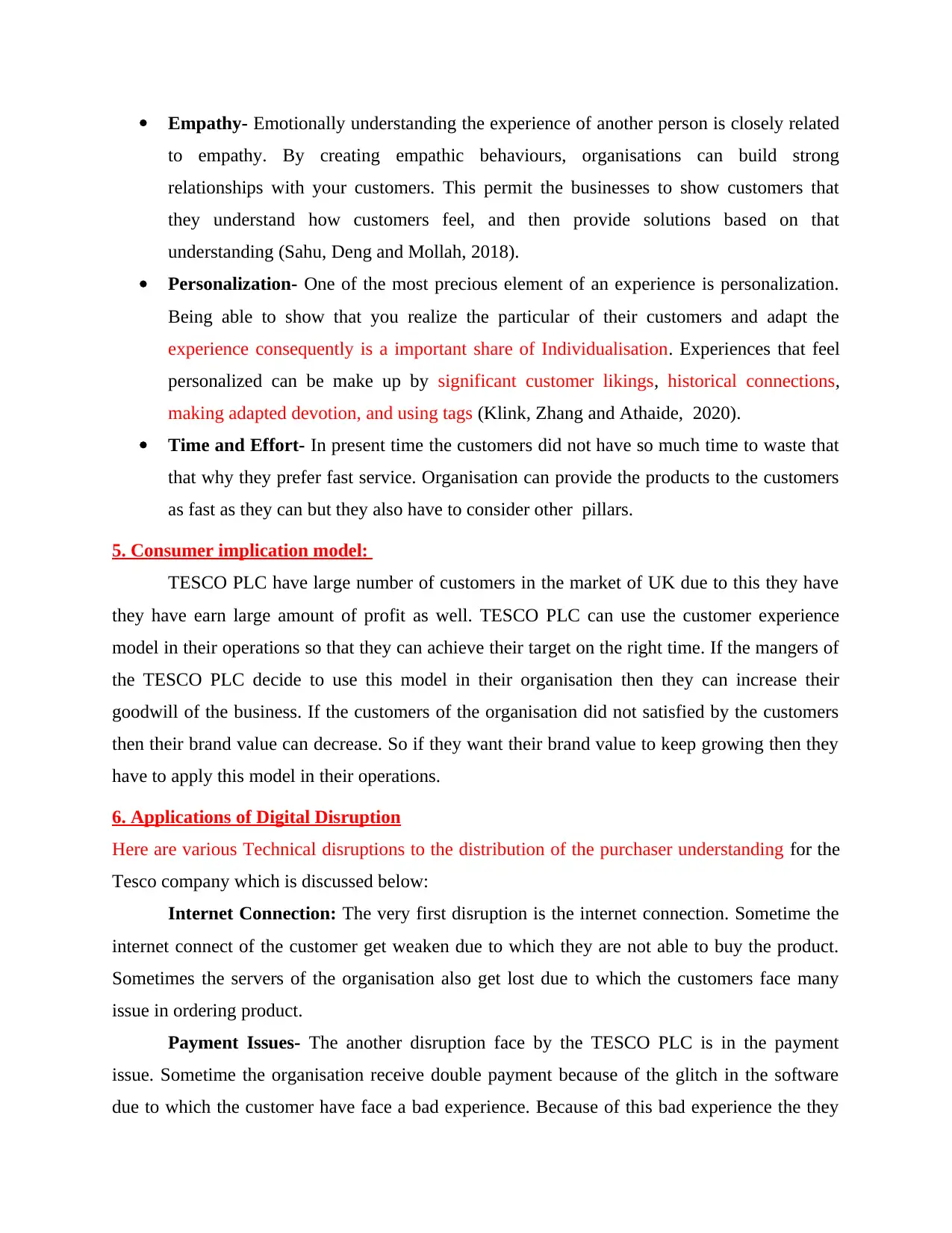
Empathy- Emotionally understanding the experience of another person is closely related
to empathy. By creating empathic behaviours, organisations can build strong
relationships with your customers. This permit the businesses to show customers that
they understand how customers feel, and then provide solutions based on that
understanding (Sahu, Deng and Mollah, 2018).
Personalization- One of the most precious element of an experience is personalization.
Being able to show that you realize the particular of their customers and adapt the
experience consequently is a important share of Individualisation. Experiences that feel
personalized can be make up by significant customer likings, historical connections,
making adapted devotion, and using tags (Klink, Zhang and Athaide, 2020).
Time and Effort- In present time the customers did not have so much time to waste that
that why they prefer fast service. Organisation can provide the products to the customers
as fast as they can but they also have to consider other pillars.
5. Consumer implication model:
TESCO PLC have large number of customers in the market of UK due to this they have
they have earn large amount of profit as well. TESCO PLC can use the customer experience
model in their operations so that they can achieve their target on the right time. If the mangers of
the TESCO PLC decide to use this model in their organisation then they can increase their
goodwill of the business. If the customers of the organisation did not satisfied by the customers
then their brand value can decrease. So if they want their brand value to keep growing then they
have to apply this model in their operations.
6. Applications of Digital Disruption
Here are various Technical disruptions to the distribution of the purchaser understanding for the
Tesco company which is discussed below:
Internet Connection: The very first disruption is the internet connection. Sometime the
internet connect of the customer get weaken due to which they are not able to buy the product.
Sometimes the servers of the organisation also get lost due to which the customers face many
issue in ordering product.
Payment Issues- The another disruption face by the TESCO PLC is in the payment
issue. Sometime the organisation receive double payment because of the glitch in the software
due to which the customer have face a bad experience. Because of this bad experience the they
to empathy. By creating empathic behaviours, organisations can build strong
relationships with your customers. This permit the businesses to show customers that
they understand how customers feel, and then provide solutions based on that
understanding (Sahu, Deng and Mollah, 2018).
Personalization- One of the most precious element of an experience is personalization.
Being able to show that you realize the particular of their customers and adapt the
experience consequently is a important share of Individualisation. Experiences that feel
personalized can be make up by significant customer likings, historical connections,
making adapted devotion, and using tags (Klink, Zhang and Athaide, 2020).
Time and Effort- In present time the customers did not have so much time to waste that
that why they prefer fast service. Organisation can provide the products to the customers
as fast as they can but they also have to consider other pillars.
5. Consumer implication model:
TESCO PLC have large number of customers in the market of UK due to this they have
they have earn large amount of profit as well. TESCO PLC can use the customer experience
model in their operations so that they can achieve their target on the right time. If the mangers of
the TESCO PLC decide to use this model in their organisation then they can increase their
goodwill of the business. If the customers of the organisation did not satisfied by the customers
then their brand value can decrease. So if they want their brand value to keep growing then they
have to apply this model in their operations.
6. Applications of Digital Disruption
Here are various Technical disruptions to the distribution of the purchaser understanding for the
Tesco company which is discussed below:
Internet Connection: The very first disruption is the internet connection. Sometime the
internet connect of the customer get weaken due to which they are not able to buy the product.
Sometimes the servers of the organisation also get lost due to which the customers face many
issue in ordering product.
Payment Issues- The another disruption face by the TESCO PLC is in the payment
issue. Sometime the organisation receive double payment because of the glitch in the software
due to which the customer have face a bad experience. Because of this bad experience the they
Paraphrase This Document
Need a fresh take? Get an instant paraphrase of this document with our AI Paraphraser
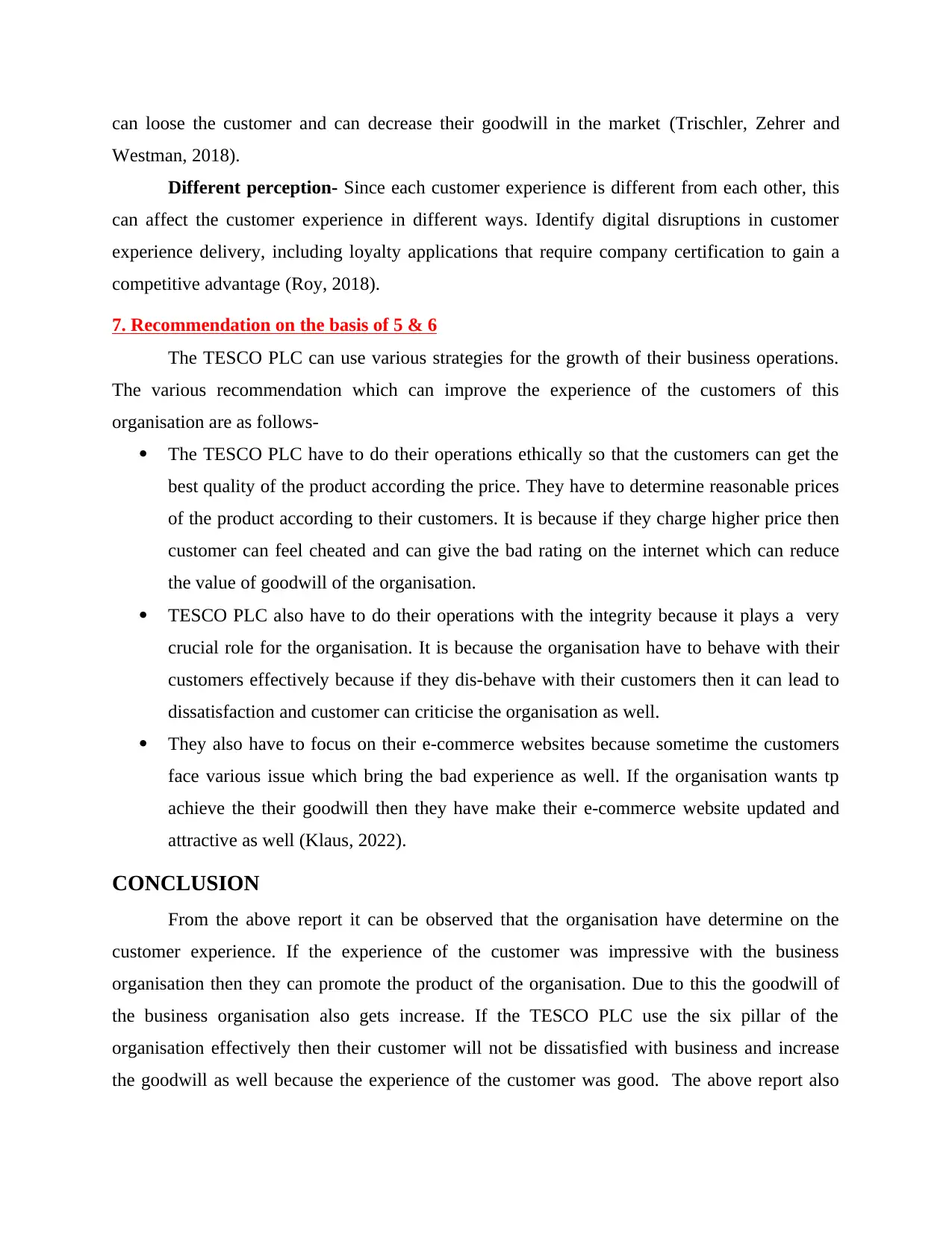
can loose the customer and can decrease their goodwill in the market (Trischler, Zehrer and
Westman, 2018).
Different perception- Since each customer experience is different from each other, this
can affect the customer experience in different ways. Identify digital disruptions in customer
experience delivery, including loyalty applications that require company certification to gain a
competitive advantage (Roy, 2018).
7. Recommendation on the basis of 5 & 6
The TESCO PLC can use various strategies for the growth of their business operations.
The various recommendation which can improve the experience of the customers of this
organisation are as follows-
The TESCO PLC have to do their operations ethically so that the customers can get the
best quality of the product according the price. They have to determine reasonable prices
of the product according to their customers. It is because if they charge higher price then
customer can feel cheated and can give the bad rating on the internet which can reduce
the value of goodwill of the organisation.
TESCO PLC also have to do their operations with the integrity because it plays a very
crucial role for the organisation. It is because the organisation have to behave with their
customers effectively because if they dis-behave with their customers then it can lead to
dissatisfaction and customer can criticise the organisation as well.
They also have to focus on their e-commerce websites because sometime the customers
face various issue which bring the bad experience as well. If the organisation wants tp
achieve the their goodwill then they have make their e-commerce website updated and
attractive as well (Klaus, 2022).
CONCLUSION
From the above report it can be observed that the organisation have determine on the
customer experience. If the experience of the customer was impressive with the business
organisation then they can promote the product of the organisation. Due to this the goodwill of
the business organisation also gets increase. If the TESCO PLC use the six pillar of the
organisation effectively then their customer will not be dissatisfied with business and increase
the goodwill as well because the experience of the customer was good. The above report also
Westman, 2018).
Different perception- Since each customer experience is different from each other, this
can affect the customer experience in different ways. Identify digital disruptions in customer
experience delivery, including loyalty applications that require company certification to gain a
competitive advantage (Roy, 2018).
7. Recommendation on the basis of 5 & 6
The TESCO PLC can use various strategies for the growth of their business operations.
The various recommendation which can improve the experience of the customers of this
organisation are as follows-
The TESCO PLC have to do their operations ethically so that the customers can get the
best quality of the product according the price. They have to determine reasonable prices
of the product according to their customers. It is because if they charge higher price then
customer can feel cheated and can give the bad rating on the internet which can reduce
the value of goodwill of the organisation.
TESCO PLC also have to do their operations with the integrity because it plays a very
crucial role for the organisation. It is because the organisation have to behave with their
customers effectively because if they dis-behave with their customers then it can lead to
dissatisfaction and customer can criticise the organisation as well.
They also have to focus on their e-commerce websites because sometime the customers
face various issue which bring the bad experience as well. If the organisation wants tp
achieve the their goodwill then they have make their e-commerce website updated and
attractive as well (Klaus, 2022).
CONCLUSION
From the above report it can be observed that the organisation have determine on the
customer experience. If the experience of the customer was impressive with the business
organisation then they can promote the product of the organisation. Due to this the goodwill of
the business organisation also gets increase. If the TESCO PLC use the six pillar of the
organisation effectively then their customer will not be dissatisfied with business and increase
the goodwill as well because the experience of the customer was good. The above report also
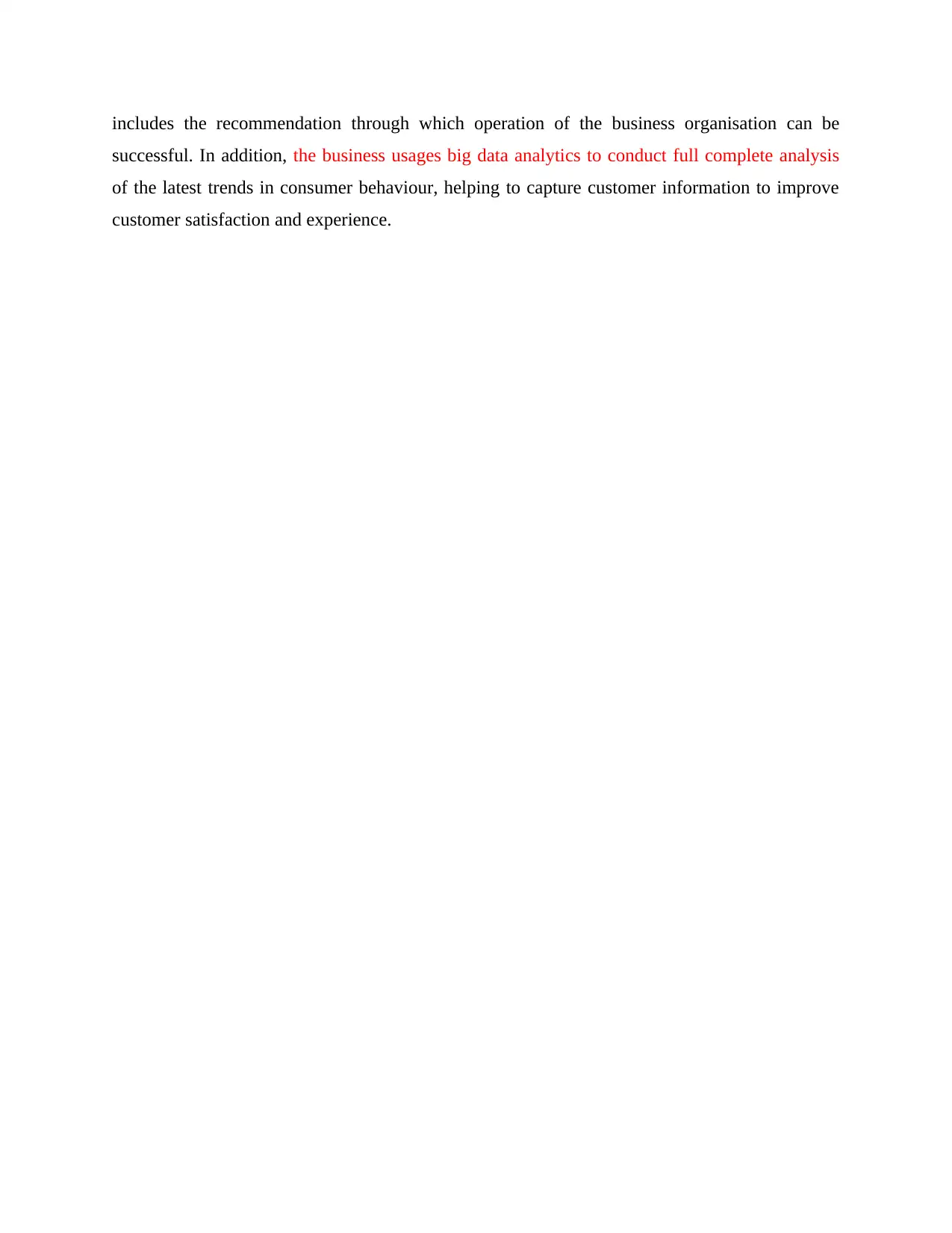
includes the recommendation through which operation of the business organisation can be
successful. In addition, the business usages big data analytics to conduct full complete analysis
of the latest trends in consumer behaviour, helping to capture customer information to improve
customer satisfaction and experience.
successful. In addition, the business usages big data analytics to conduct full complete analysis
of the latest trends in consumer behaviour, helping to capture customer information to improve
customer satisfaction and experience.
⊘ This is a preview!⊘
Do you want full access?
Subscribe today to unlock all pages.

Trusted by 1+ million students worldwide
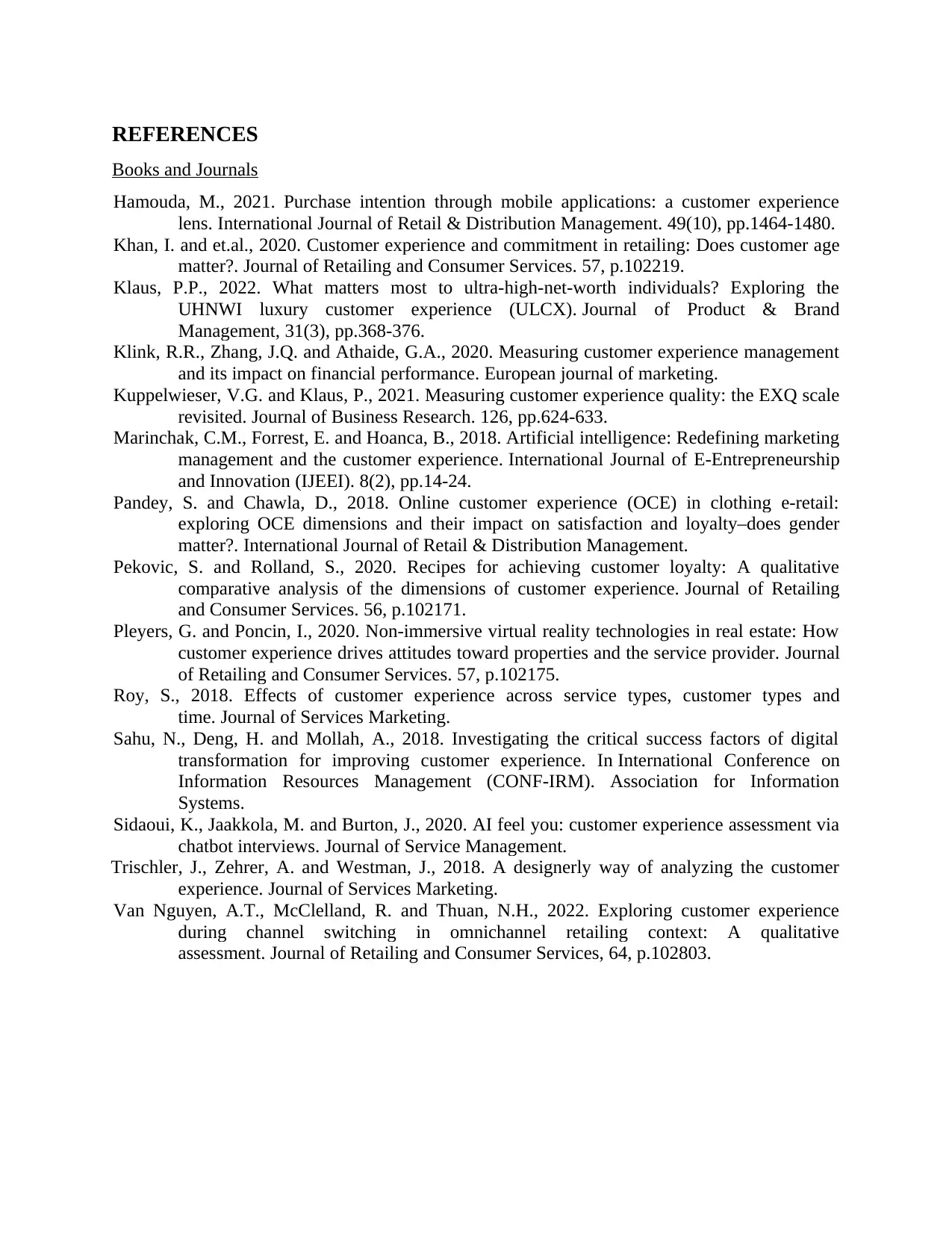
REFERENCES
Books and Journals
Hamouda, M., 2021. Purchase intention through mobile applications: a customer experience
lens. International Journal of Retail & Distribution Management. 49(10), pp.1464-1480.
Khan, I. and et.al., 2020. Customer experience and commitment in retailing: Does customer age
matter?. Journal of Retailing and Consumer Services. 57, p.102219.
Klaus, P.P., 2022. What matters most to ultra-high-net-worth individuals? Exploring the
UHNWI luxury customer experience (ULCX). Journal of Product & Brand
Management, 31(3), pp.368-376.
Klink, R.R., Zhang, J.Q. and Athaide, G.A., 2020. Measuring customer experience management
and its impact on financial performance. European journal of marketing.
Kuppelwieser, V.G. and Klaus, P., 2021. Measuring customer experience quality: the EXQ scale
revisited. Journal of Business Research. 126, pp.624-633.
Marinchak, C.M., Forrest, E. and Hoanca, B., 2018. Artificial intelligence: Redefining marketing
management and the customer experience. International Journal of E-Entrepreneurship
and Innovation (IJEEI). 8(2), pp.14-24.
Pandey, S. and Chawla, D., 2018. Online customer experience (OCE) in clothing e-retail:
exploring OCE dimensions and their impact on satisfaction and loyalty–does gender
matter?. International Journal of Retail & Distribution Management.
Pekovic, S. and Rolland, S., 2020. Recipes for achieving customer loyalty: A qualitative
comparative analysis of the dimensions of customer experience. Journal of Retailing
and Consumer Services. 56, p.102171.
Pleyers, G. and Poncin, I., 2020. Non-immersive virtual reality technologies in real estate: How
customer experience drives attitudes toward properties and the service provider. Journal
of Retailing and Consumer Services. 57, p.102175.
Roy, S., 2018. Effects of customer experience across service types, customer types and
time. Journal of Services Marketing.
Sahu, N., Deng, H. and Mollah, A., 2018. Investigating the critical success factors of digital
transformation for improving customer experience. In International Conference on
Information Resources Management (CONF-IRM). Association for Information
Systems.
Sidaoui, K., Jaakkola, M. and Burton, J., 2020. AI feel you: customer experience assessment via
chatbot interviews. Journal of Service Management.
Trischler, J., Zehrer, A. and Westman, J., 2018. A designerly way of analyzing the customer
experience. Journal of Services Marketing.
Van Nguyen, A.T., McClelland, R. and Thuan, N.H., 2022. Exploring customer experience
during channel switching in omnichannel retailing context: A qualitative
assessment. Journal of Retailing and Consumer Services, 64, p.102803.
Books and Journals
Hamouda, M., 2021. Purchase intention through mobile applications: a customer experience
lens. International Journal of Retail & Distribution Management. 49(10), pp.1464-1480.
Khan, I. and et.al., 2020. Customer experience and commitment in retailing: Does customer age
matter?. Journal of Retailing and Consumer Services. 57, p.102219.
Klaus, P.P., 2022. What matters most to ultra-high-net-worth individuals? Exploring the
UHNWI luxury customer experience (ULCX). Journal of Product & Brand
Management, 31(3), pp.368-376.
Klink, R.R., Zhang, J.Q. and Athaide, G.A., 2020. Measuring customer experience management
and its impact on financial performance. European journal of marketing.
Kuppelwieser, V.G. and Klaus, P., 2021. Measuring customer experience quality: the EXQ scale
revisited. Journal of Business Research. 126, pp.624-633.
Marinchak, C.M., Forrest, E. and Hoanca, B., 2018. Artificial intelligence: Redefining marketing
management and the customer experience. International Journal of E-Entrepreneurship
and Innovation (IJEEI). 8(2), pp.14-24.
Pandey, S. and Chawla, D., 2018. Online customer experience (OCE) in clothing e-retail:
exploring OCE dimensions and their impact on satisfaction and loyalty–does gender
matter?. International Journal of Retail & Distribution Management.
Pekovic, S. and Rolland, S., 2020. Recipes for achieving customer loyalty: A qualitative
comparative analysis of the dimensions of customer experience. Journal of Retailing
and Consumer Services. 56, p.102171.
Pleyers, G. and Poncin, I., 2020. Non-immersive virtual reality technologies in real estate: How
customer experience drives attitudes toward properties and the service provider. Journal
of Retailing and Consumer Services. 57, p.102175.
Roy, S., 2018. Effects of customer experience across service types, customer types and
time. Journal of Services Marketing.
Sahu, N., Deng, H. and Mollah, A., 2018. Investigating the critical success factors of digital
transformation for improving customer experience. In International Conference on
Information Resources Management (CONF-IRM). Association for Information
Systems.
Sidaoui, K., Jaakkola, M. and Burton, J., 2020. AI feel you: customer experience assessment via
chatbot interviews. Journal of Service Management.
Trischler, J., Zehrer, A. and Westman, J., 2018. A designerly way of analyzing the customer
experience. Journal of Services Marketing.
Van Nguyen, A.T., McClelland, R. and Thuan, N.H., 2022. Exploring customer experience
during channel switching in omnichannel retailing context: A qualitative
assessment. Journal of Retailing and Consumer Services, 64, p.102803.
1 out of 10
Related Documents
Your All-in-One AI-Powered Toolkit for Academic Success.
+13062052269
info@desklib.com
Available 24*7 on WhatsApp / Email
![[object Object]](/_next/static/media/star-bottom.7253800d.svg)
Unlock your academic potential
Copyright © 2020–2025 A2Z Services. All Rights Reserved. Developed and managed by ZUCOL.




